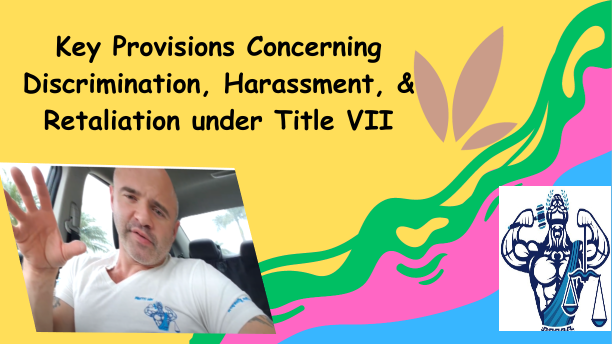Here at the Law Office of Vincent Miletti, Esq. and the home of the #UnusuallyMotivated movement, we take pride as a resilient and dependable legal services firm, providing such services in both a traditional and online, web-based environment. With mastered specialization in areas such as Employment and Labor Law, Intellectual Property (IP) (trademark, copyright, patent), Entertainment Law, and e-Commerce (Supply Chain, Distribution, Fulfillment, Standard Legal & Regulatory), we provide a range of legal services including, but not limited to traditional legal representation (litigation, mediation, arbitration, opinion letters, and advisory), non-litigated business legal representation and legal counsel, and unique, online legal services such as smart forms, mobile training, legal marketing, and development.
Still, here at Miletti Law®, we feel obligated to enlighten, educate, and create awareness about how these issues and many others affect our unusually motivated® readers and/or their businesses. Accordingly, to achieve this goal, we have committed ourselves to create authoritative, trustworthy, & distinctive content. Usually, this content is featured as videos posted on our YouTube Channel https://www.youtube.com/channel/UCtvUryqkkMAJLwrLu2BBt6w and blogs that are published on our website WWW.MILETTILAW.COM. With that, the ball is in your court and you have an effortless obligation to subscribe to the channel and sign up for the Newsletter on the website, which encompasses the best way to ensure that you stay in the loop and feel the positive impact of the knowledge bombs that we drop here!
As the authoritative force in Employment Law, it only seemed right to introduce one of the many upcoming series where we remain persistent in introducing a variety of topics, which will look to not only educate but also deliver in a sense that only Miletti Law® can. In this regard, this blog is Part XVI of our series on “Cybersecurity Measures to Protect Employers.” In Part XV, we hammered on “Identifying Who Caused or Was Involved With the Breach,” another key thing all employers should do following a trade secret data breach in their businesses. As a way of continuing with our discussion, we have, in this blog and Part XVI, hammered on “Identifying the Lost, Stolen, and/or Misappropriated Trade Secrets,” which is also another vital task for employers who have experienced trade secret data breaches in their businesses.
Identifying the Lost, Stolen, and/or Misappropriated Trade Secrets
A trade secret may comprise many types of information and data. Small and big businesses alike can have a huge count of trade secrets, including but not limited to marketing plans, client/customer lists, financial information, and production/product blueprints. This is why structured and advanced systems for identifying, valuing, and protecting their trade secrets should be implemented and adopted by all employers. Accordingly, employers should find it crucial to define and know their trade secret(s), the value that those trade secrets have for their businesses and, consequently, identify any that may have been misappropriated following a trade secret data breach.
This implies that with such information at hand, employers may be able to respond to trade secret data breach incidents promptly, especially since valuable resources and time may be required in order to identify any compromised or misappropriated trade secrets. As mentioned in a past blog under this series, the argument that one took reasonable steps in protecting their trade secrets may be strengthened by an employer’s ability to respond to misappropriation promptly. Accordingly, it also implies that since a jury may question and fail to get convinced by a claim that a plaintiff and/or businesses would face irreparable harm following the denial of a preliminary injunction, an employer should make haste to obtain a temporary restraining order (TRO) and/or preliminary injunction.
The Need for Trade Secret Audits
As part of identifying the value of a business’s trade secrets, employers should, as a best practice, make it a habit to identify, categorize, and implement cybersecurity protection measures to reinforce the secrecy of their trade secrets. Usually, despite the availability of multiple techniques, such identification, categorization, and implementation may be accomplished through a trade secret audit. Although they may lack the requisite expertise for identifying and categorizing trade secret(s), a company or business’s staff may be tasked with the duty of conducting trade secret manual audits.
Otherwise, although this could be costly, a company may seek the services of experts with the required knowledge and expertise to conduct such audits. However, seeking audit consultants may prove advantageous to a company or business since experts are, due to their expertise, thorough and could become pivotal witnesses when lawsuits related to trade secret data breaches arise, especially because the interaction would provide them with key information regarding the business, employees, and employer. Further, such audits may also be conducted technologically through what is known as a computer-automated audit, which, in order to identify valuable information comprising trade secrets, utilizes software programs for extracting and analyzing trade secret data.
In Part XVII, we shall switch gears and provide you with a hands-on guide regarding why employers should consider bringing claims under the Computer Fraud and Abuse Act in the case of trade secret data breaches in our blog titled “Bringing Claims under the Computer Fraud and Abuse Act (CFAA).”
Until then, stay tuned for more legal guidance, training, and education. In the interim, if there are any questions or comments, please let us know at the Contact Us page!
Always rising above the bar,
Isaac T.,
Legal Writer & Author.
 314-648-2586
314-648-2586 CALL US NOW
CALL US NOW







